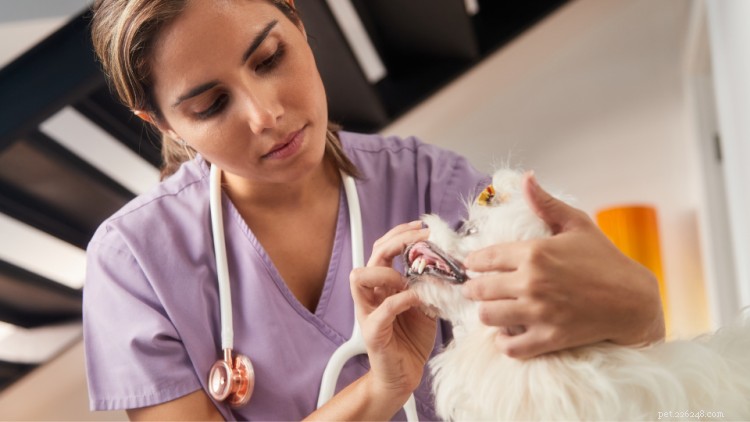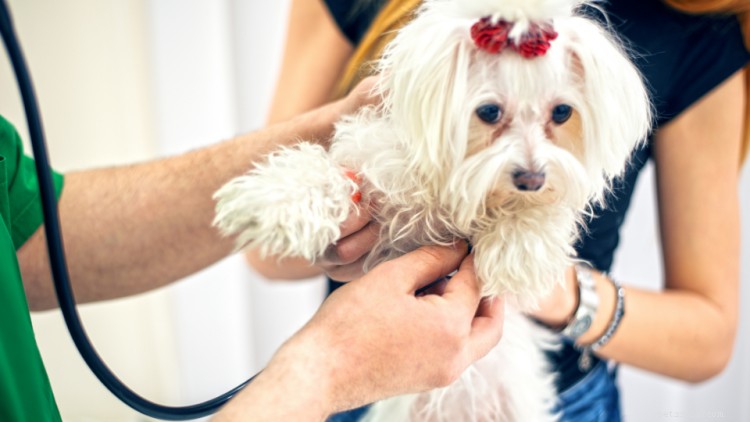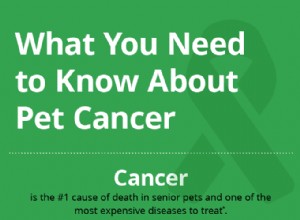ペットの飼い主として、ペットの生活の質と量を最大限に高めるために、できる限りのことをしたいと考えています。うまくいけば、あなたはかかりつけの獣医師と関係を築き、ペットの予防ケアに関する推奨事項に従っていることでしょう。予防接種の予定がない場合、特にペットが獣医のオフィスでストレスを感じやすい場合は、毎年の獣医の予約をスキップしたくなるかもしれませんが、毎年の健康診断は、ペットの健康を維持するために不可欠です .
近くの獣医を探す
ペット ウェルネス プランは価値がありますか?
ペットは病気の初期の兆候を隠すのが非常に得意です そのため、人間の家族が最も治療可能な病気を発見するのは難しい場合があります。年に一度のペットチェックにより、獣医師は、自宅では検出できない病気や痛みの微妙な兆候についてペットを評価することができます.健康診断から得られた情報により、獣医師は、ペットの健康を最大限に高めるための診断テスト、食事、活動、投薬やサプリメントに関する具体的な推奨事項を作成できます。
ペットの年次検査の各部分で獣医師が何を求めているかについて詳しく知るために、以下をお読みください。
ウェルネス試験の獣医の予約中に期待されることは次のとおりです。
健康診断は、獣医がペットに触れる前から始まります。彼または彼女は、あなたのペットが検査室をどのように動き回るかを観察し、こわばりや跛行がないかチェックします。 (筋骨格系の痛みの徴候である可能性があります)および運動失調、またはバランスの崩れ (これは、いくつかの神経学的状態の徴候である可能性があります)。
さらに、一部の病気はペットの外見を変える可能性があります。 これの典型的な例はクッシング症候群です 、これはあなたの犬の太鼓腹の外観と貧弱な毛のコートにつながる可能性があります.獣医師は、犬の身体検査チェックリストに従って、以下の視覚的評価を行います。
あなたの獣医は、残りの訪問を通して、犬の身体検査チェックリストの領域をさらに評価します. この獣医チェックの最初の視覚的部分は、多くの場合 1 分以内に終了し、それが行われていることに気付かない場合もあります。
この間、獣医は試験室でのペットの行動や態度を評価して、試験中の猫や犬の最善の扱い方を決定します。 .獣医に行くのが好きなペットもいれば、恐怖や攻撃性を示すボディーランゲージを示すペットもいます。場合によっては、獣医師が、検査中の保護のためにペットの口に銃口を装着することを勧める場合があります。
ペットがあなたを守っている場合、獣医師は部屋から出るか、治療エリアでペットを診察するよう勧めるかもしれません .これは、ペットと獣医チームの安全を確保するためです。飼い主を保護するペットの多くは、飼い主から離れると獣医チームと喜んで交流し、もはや保護する必要性を感じなくなります.
ペットが非常に怖がりまたは攻撃的である場合 (多くの場合、恐怖によって引き起こされます)、獣医は予約の変更を勧め、経口鎮静剤を処方する場合があります。 トラゾドンやガバペンチンなどを次回の訪問までに使用してください。これは、安全と、ペットが経験しているストレスと恐怖を軽減するために行われます。
あなたのペットの体重は獣医の予約ごとに記録され、増加と減少の両方の変化が議論されます. ペットの体重を意図的に減量または増量させようとしている場合は、必ず獣医師に知らせてください。
米国のペット人口では肥満が一般的であり、関節疾患、糖尿病、その他の二次的な健康問題のリスクを高めます .また、ペットの寿命を短くすることも示されています。ペットが太りすぎていたり、不健康な方法で体重が増えている場合は、獣医師が減量の戦略について話し合います。 体重増加または減量不能は、犬の甲状腺機能低下症などの代謝性疾患の徴候である可能性もあります。
体重減少は体内疾患の指標にもなり得ます 腎臓病、糖尿病、甲状腺機能亢進症、さらには癌など。高齢のペットでは、筋肉の減少により体重が減少することがあります。体重減少が認められた場合、特に食欲、喉の渇き、排尿、またはエネルギーレベルの変化と組み合わされている場合、獣医師はおそらく追加の検査を勧めるでしょう.
多くの獣医師は、ペットの歯茎を評価することから検査を開始します。 歯茎は、色と水分に基づいて全体的な健康状態を評価するのに役立ちます .異常な歯茎の色は、貧血 (赤血球の減少)、肝臓病、または呼吸器系や循環器系の問題を示唆している可能性があります .歯ぐきが乾いて粘着性がある場合は、脱水症状を示唆しています 、これは病気の別の兆候である可能性があります。
次に、ペットの口を評価して、歯周病(歯肉)の病気や歯の異常の兆候を調べます。 歯周病は犬の 80% 以上に存在します アメリカ獣医学会によると、口臭 (口臭)、痛み、感染症を引き起こす可能性があります。
口内の細菌負荷は、他の臓器にも影響を与える可能性があります。 重度の疾患の患者でさえ、食欲やドライフードを食べる能力に変化が見られない場合があることを知っておくことが重要です。そのため、歯科疾患を検出するには年 1 回の口腔検査が重要です。
歯周病の証拠には以下が含まれます:
歯周病の証拠に加えて、獣医師はペットの口を次の点についてチェックします。

これらのいずれかが存在する場合、獣医は麻酔による歯科クリーニングを推奨する可能性があります.これは、獣医がすべての歯を完全に評価し、X線を撮って歯の構造全体を調べ、歯茎の下に追加の病気がないかどうかを確認できるようにする別の手順です.ペットの歯周病が重度である場合、または異常な歯が存在する場合は、処置中にいくつかの歯を取り除く必要がある場合があります.通常、麻酔と歯科用 X 線を使用しないと、歯の最適な治療オプションを完全に決定することはできません。
遠くから、獣医師はペットの顔の対称性に異常がないかチェックします。これは、腫れ、成長、または神経の異常を示している可能性があります .その後、耳鏡で耳を、検眼鏡で目をさらに詳しく評価します。
眼を検査する際、獣医師は、不快感を引き起こしたり、視力に影響を与えたりする可能性のある病気の兆候がないかチェックします。 Discharge can be a sign of mild irritation, conjunctivitis, or more serious conditions such as dry eye and corneal ulcers . Your veterinarian will use an ophthalmoscope to closely examine the eyelids and all of the structures of the eye, including the cornea, sclera (whites of the eye), pupils, interior of the eye, and retina for abnormalities.
Any abnormalities that might affect your pet’s comfort or vision will be discussed. Cataracts are a common problem in older pets that can affect vision and may be noticed by the owner at home. Changes in the retina can only be seen with an ophthalmoscope and may indicate hypertension, or high blood pressure, which can cause blindness and damage to other organs.
Based on the physical examination findings, your veterinarian may recommend additional tests on your pet’s eye to assess tear production, check for ulcers, and check the pressure in your pet’s eye to screen for inflammation and glaucoma.
Your pet’s ears will be assessed for discharge, inflammation, and swelling in the ear canals, which can indicate infection or the presence of ear mites . The ear canal will also be checked for abnormal growths. In a healthy ear, your veterinarian should be able to view the eardrum (or tympanic membrane). It is difficult to assess hearing in pets, but if you have concerns about your pet’s hearing, let your veterinarian know.
Finally, your vet will evaluate several structures in your pet’s neck. There are lymph nodes located under your pet’s jaw and in front of their shoulder blades, as well as other places in the body. Enlargement of these nodes can suggest infection, inflammation, or lymphoma, a type of cancer. The thyroid gland is not usually large enough to be palpated, except in some cases of hyperthyroidism, a common disease of older cats.
Your veterinarian will listen to your pet's heart and lungs with a stethoscope. This is a very important part of the exam since most pets won't show external signs of heart problems in early stages of disease.
Your veterinarian will record your pet’s heart and respiratory rate and listen for any changes in the sounds of your pet’ heart or lungs, including:
If any abnormalities are heard during the exam, your vet may recommend an electrocardiogram (ECG), x-rays, or other testing to assess your pet's heart and lungs. They may also recommend referral to a cardiologist for an echocardiogram, or full cardiac ultrasound.

Next, your vet will palpate your pet’s abdomen, checking for pain, fluid accumulation, or changes in organ size. It is important to know that in obese or very large pets (such as giant breed dogs), it can be difficult to palpate all areas of the abdomen, but important information can still be gained.
Pain can be a sign of discomfort in the abdomen itself or from another area in the body, such as the back, which is common in breeds with long spines, such as Dachshunds.
Fluid can accumulate in the abdomen for many reasons including bleeding, infection, liver disease, heart disease, and low blood protein levels . Small volumes of fluid are difficult to detect on palpation, but larger amounts can lead to visible abdominal bloating or changes in the feel of the abdomen. Any fluid accumulation is a sign of significant disease that should be investigated further.
Changes in organ size can suggest a variety of abnormalities . Enlarged organs can suggest tumors, which may be benign or malignant, or swelling. Alternatively, organs that have decreased in size, such as the kidneys, can suggest organ dysfunction or failure. These can be investigated further with bloodwork, x-rays, and ultrasound.
As a pet owner, you are likely to notice changes in your dog or cat’s skin and haircoat fairly quickly. If you've noticed new lumps or changes in old ones, bring them to your vet's attention at the beginning of the examination . Your vet will document the size and location of all lumps and may find some you haven’t found at home.
Lumps that have been present previously will be rechecked and assessed for changes. It is not possible to diagnose the type of lump by feel alone, so your vet may recommend a fine needle aspirate to investigate further.
If your pet is itching excessively or losing fur, let your veterinarian know. This can be a sign of parasites, such as fleas or skin mites, allergies, or infection . Your veterinarian will closely evaluate the skin for signs of these disease processes. The skin and hair coat can also increase a suspicion of metabolic diseases such as hypothyroidism and Cushing’s syndrome.
Finally, your vet will check your pet’s legs, back, and neck for signs of discomfort, joint disease, and neurologic dysfunction . Some breeds are predisposed to joint diseases like hip dysplasia in German Shepherd dogs, Labrador Retrievers, and others. The way your pet moves around the clinic as well as the way the joint feels can increase suspicion of this disease and other joint problems, such as luxating patellas or osteoarthritis.
While many neurologic diseases, such as seizure disorders or vestibular disease , are observed first at home, some diseases that affect mobility to the back legs, such as intervertebral disc disease (IVDD) and degenerative myelopathy , can be suspected based on physical examination based on how your pet lifts their hind feet when walking and standing.
While a single physical examination can provide a lot of important information about your pet's health, tracking findings and changes overtime is even more valuable . By having an examination performed at least once a year on your pet, you increase the chances that subtle changes will be detected. That’s why it’s crucial to schedule annual vet check-ups, even if you think your pet is perfectly healthy. Some veterinarians recommend geriatric screening for senior pets every six months, since pets age faster than we do as humans.
Physical exams do have limitations. A veterinarian’s hands cannot tell them how a pet’s organs are functioning. This is why your veterinarian may recommend bloodwork to assess organ function in older pets even with a normal examination. As discussed above, diagnostics are recommended for pets with abnormalities on their exam.
A vet check-up costs between $50 and $70 on average . Most practices charge the same for wellness exams as they do for general office visits, however, prices increase with recommended testing, which makes senior pet checks typically more expensive.
The cost of a vet check-up also varies based on where you live. Generally, veterinary services on the West Coast are a bit more expensive than the East Coast, which are both significantly higher than prices in less-populated areas of the country, like the Mid West.
For example, a canine health check at a vet in San Diego costs about $73 . The same dog check-up costs approximately $55 in Lincoln, NE, where you can find some of the lowest vet prices for dogs in the U.S.
In comparison, the cat check-up cost at vets in New York City is about $77 , while the same office visit runs about $52 in Oklahoma City.
Investing in pet insurance can help to provide a financial safety net if abnormalities are found on your pet's examination and additional diagnostics are recommended. Pet insurance can reimburse you for up to 90% of your total bill.
Some providers offer pet wellness plans as add-ons that will also cover your annual examination and routine screening tests. By investing in pet insurance, you can have the peace of mind that any abnormalities found on your pet's annual examination can be diagnosed and treated appropriately.
Find A Vet Near Me
Are Pet Wellness Plans Worth It?

CBD、またはカンナビジオールは、現在すべての怒りです。猫と犬のためのCBD製品を含む、販売可能なCBDアイテムの膨大な配列があります。しかし、CBDとは何ですか?ペットに関してはどのように使用する必要がありますか? CBDとは何ですか? CBDは、大麻植物に含まれる化合物を意味するカンナビノイドです。大麻植物には、多くの異なるカンナビノイドが含まれています。 60を超えると言う人もいれば、100を超えると言う人もいます。科学はまだはっきりしていません。これらのカンナビノイドのうち、おそらく聞いたことがあるタイプは、テトラヒドロカンナビノール(THC)とカンナビジオール(CBD)です。

全国ペットがん啓発月間は 11 月です。毎年より多くのペットが癌と診断されていますが、早期発見と治療に関しては、動物の健康管理が進歩しています。がんの兆候と治療法の選択肢について学びましょう。 ペットガンの事実 がんは高齢のペットの死因の第 1 位であり、治療費が最も高額な病気の 1 つです。* 犬の 4 匹に 1 匹は、生涯のうちにがんを発症します。 猫の 5 匹に 1 匹は、生涯のうちにがんを発症します。 ご存じですか:犬は人間とほぼ同じ割合でがんにかかります。 朗報:化学療法やハイテク手術などの治療オプションは、ペットががんを克服するのに役立ちます。 がん治療の平均費用**: